Control Strategy for Resonant Inverter in High Frequency AC Power Distribution System with Harmonic Suppression and Transient Performance Improvement
Abstract
1. Introduction
2. Harmonic Analysis and Open Loop System Description
2.1. Harmonic Analysis for Resonant Inverter
2.2. Performance Description of the Open Loop System
3. Closed Loop Control and Performance Analysis of the System
3.1. Control Strategy and Analysis Based on PIR
3.2. I-PSM Method
3.3. Performance Analysis of Closed Loop System
4. Experimental Results
5. Conclusions
Author Contributions
Funding
Institutional Review Board Statement
Informed Consent Statement
Data Availability Statement
Acknowledgments
Conflicts of Interest
References
- Hansen, I.-G. Status of 20kHz Space Station Power Distribution Technology; TM 100781; NASA: Washington, DC, USA, 1988. [Google Scholar]
- Ng, S.-Y.; Luk, P.-C.; Ken, J. High frequency AC distributed power system for fluorescent lighting. In Proceedings of the 2011 14th European Conference on Power Electronics and Applications, Birmingham, UK, 30 August–1 September 2011; Volume 1, pp. 1–10. [Google Scholar]
- Jain, P.; Pinheiro, H. Hybrid high frequency AC power distribution architecture for telecommunication systems. IEEE Trans. Aerosp. Electron. Syst. 1999, 35, 138–147. [Google Scholar] [CrossRef]
- Bose, B.; Kin, M.-H.; Kankam, M.-D. High frequency AC vs. DC distribution system for next generation hybrid electric vehicle. In Proceedings of the 1996 IEEE IECON 22nd International Conference on Industrial Electronics, Control, and Instrumentation, Taipei, Taiwan, 9 August 1996; Volume 2, pp. 706–712. [Google Scholar]
- Ma, X. High frequency AC pulse density modulation theory and its application in hybrid electric vehicle drive system. In Proceedings of the 4th International Power Electronics and Motion Control Conference, Xi’an, China, 14–16 August 2004; Volume 2, pp. 827–830. [Google Scholar]
- Chakraborty, S.; Simoes, M.-G. Experimental evaluation of active filtering in a single-phase high-frequency AC microgrid. IEEE Trans. Energy Convers. 2009, 24, 673–682. [Google Scholar] [CrossRef]
- Moo, C.-S.; Chen, W.-M.; Hsieh, H.-K. Electronic ballast with piezoelectric transformer for cold cathode fluorescent lamps. IEE Proc.-Electr. Power Appl. 2003, 50, 278–282. [Google Scholar] [CrossRef]
- Jain, P.; Pahlevaninezhad, M.; Pan, S.; Drobnik, J. A Review of high-frequency power distribution systems: For space, telecommunication, and computer applications. IEEE Trans. Power Electron. 2014, 29, 3852–3863. [Google Scholar] [CrossRef]
- Ye, Z.; Jain, P.-K.; Sen, P.-C. A full-bridge resonant inverter with modified phase-shift modulation for high-frequency AC power distribution systems. IEEE Trans. Ind. Electron. 2007, 54, 2831–2845. [Google Scholar]
- Liu, J.; Cheng, K.-W.-E. μ-based robust controller design of LCLC resonant inverter for high-frequency power distribution system. IET Power Electron. 2013, 6, 652–662. [Google Scholar] [CrossRef]
- Liu, J.; Zeng, J. An integrated controller for high-frequency LCLC resonant inverter with phase-shifted control and frequency regulation. Int. J. Circ. Theor. Appl. 2017, 45, 47–62. [Google Scholar] [CrossRef]
- Nabinejad, A.; Rajaei, A.; Mardaneh, M. A systematic approach to extract state-space averaged equations and small-signal model of partial-power converters. IEEE J. Emerg. Select. Top. Power Electron. 2020, 8, 2475–2483. [Google Scholar] [CrossRef]
- Azer, P.; Emadi, A. Generalized state space average model for multi-phase interleaved buck, boost and buck-boost DC-DC converters: Transient, steady-state and switching dynamics. IEEE Access 2020, 8, 77735–77745. [Google Scholar] [CrossRef]
- Sanders, S.-R.; Noworolski, J.-M. Generalized averaging method for power conversion circuits. IEEE Trans. Power Electron. 1991, 6, 251–259. [Google Scholar] [CrossRef]
- Mohammadi, M.; Degioanni, F.; Mahdavi, M.; Ordonez, M. Small-signal modeling of LLC converters using homopolarity cycle. IEEE Trans. Power Electron. 2020, 35, 4076–4093. [Google Scholar] [CrossRef]
- Qiu, M.; Jain, P.-K.; Zhang, H. An APWM resonant inverter topology for high frequency AC power distribution systems. IEEE Trans. Power Electron. 2004, 19, 121–129. [Google Scholar] [CrossRef]
- Ye, Z.; Jain, P.-K.; Sen, P.-C. A two-stage resonant inverter with control of the phase angle and magnitude of the output voltage. IEEE Trans. Power Electron. 2007, 54, 2797–2812. [Google Scholar]
- Herman, L.; Papic, I.; Blazic, B. A proportional-resonant current controller for selective harmonic compensation in a hybrid active power filter. IEEE Trans. Power Deliv. 2014, 29, 2055–2065. [Google Scholar] [CrossRef]
- Lee, T.; Hu, S. An active filter with resonant current control to suppress harmonic resonance in a distribution power system. IEEE J. Emerg. Select. Top. Power Electron. 2016, 4, 198–209. [Google Scholar] [CrossRef]
- Zhou, S.; Zhang, Y.; Liu, Z.; Liu, J.; Zhou, L. Implementation of cross-coupling terms in proportional-resonant current control schemes for improving current tracking performance. IEEE Trans. Power Electron. 2021, 36, 13248–13260. [Google Scholar] [CrossRef]
- Yepes, A.-G.; Freijedo, F.-D.; Lopez, Ó.; Doval-Gandoy, J. Analysis and design of resonant current controllers for voltage-source converters by means of Nyquist diagrams and sensitivity function. IEEE Trans. Ind. Electron. 2011, 58, 5231–5250. [Google Scholar] [CrossRef]
- Trinh, Q.-N.; Wang, P.; Choo, F.-H. An improved control strategy of three-phase PWM rectifiers under input voltage distortions and DC-offset measurement errors. IEEE J. Emerg. Select. Top. Power Electron. 2017, 5, 1164–1176. [Google Scholar] [CrossRef]
- Lakka, M.; Koutroulis, E.; Dollas, A. Development of an FPGA-based SPWM generator for high switching frequency DC/AC inverters. IEEE Trans. Power Electron. 2014, 29, 356–365. [Google Scholar] [CrossRef]
- Jammala, V.; Yellasiri, S.; Panda, A.-K. Development of a new hybrid multilevel inverter using modified carrier SPWM switching strategy. IEEE Trans. Power Electron. 2018, 33, 8192–8197. [Google Scholar] [CrossRef]
- Sarker, R.; Datta, A.; Debnath, S. FPGA-based high-definition SPWM generation with harmonic mitigation property for voltage source inverter applications. IEEE Trans. Ind. Inf. 2021, 17, 1352–1362. [Google Scholar] [CrossRef]
- Liu, J.; Cheng, K.-W.-E.; Ye, Y. A cascaded multilevel inverter based on switched-capacitor for high-frequency AC power distribution system. IEEE Trans. Power Electron. 2014, 29, 4219–4230. [Google Scholar] [CrossRef]
- IEEE Std 1547.2-2008; IEEE Standard for Interconnecting Distributed Resources with Electric Power Systems. IEEE Application Guide for IEEE Std 1547(TM); IEEE: Piscataway, NJ, USA, 2009; pp. 1–217.
- IEEE Std 519-2014; IEEE Recommended Practice and Requirements for Harmonic Control in Electric Power Systems. IEEE Application Guide for IEEE Std 519(TM), Revision of IEEE Std 519-1992; IEEE: Piscataway, NJ, USA, 2014; pp. 1–29.
- Nian, H.; Song, Y. Optimised parameter design of proportional integral and resonant current regulator for doubly fed induction generator during grid voltage distortion. IET Renew. Power Gener. 2014, 8, 299–313. [Google Scholar] [CrossRef]
- Chan, H.-L.; Cheng, K.-W.-E.; Sutanto, D. Bidirectional phase-shifted DC-DC converter. Electron. Lett. 1999, 35, 523–524. [Google Scholar] [CrossRef]


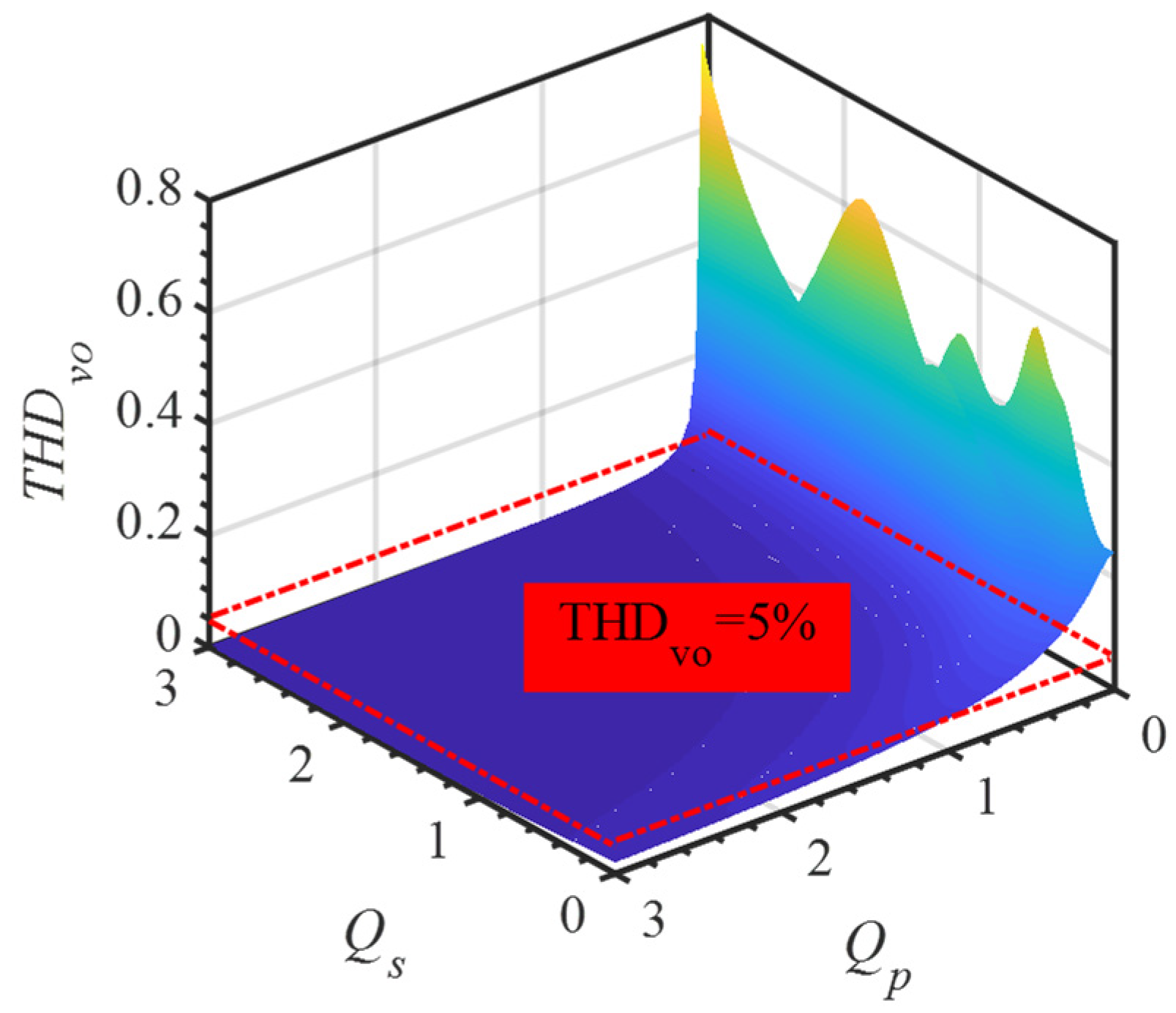


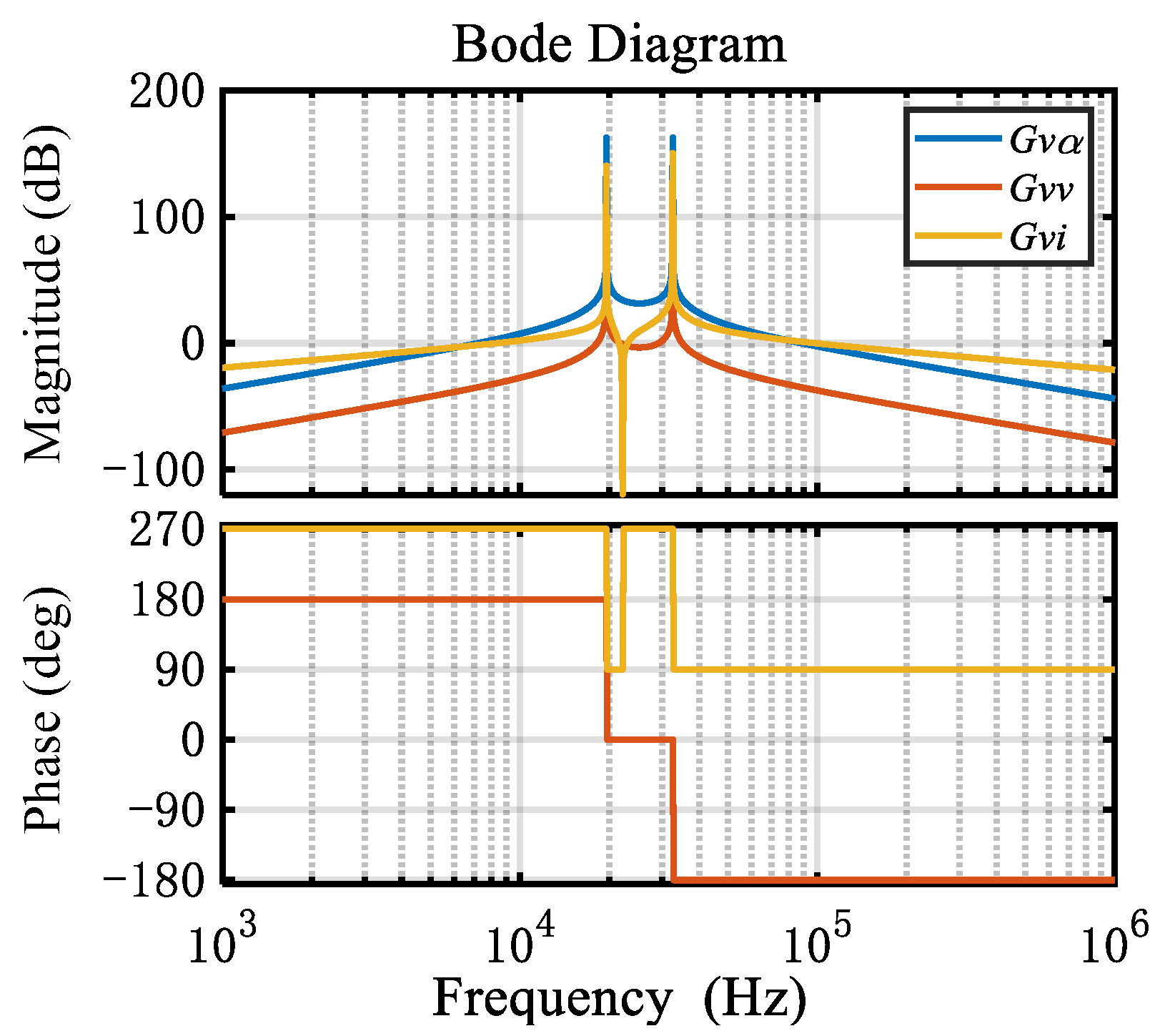
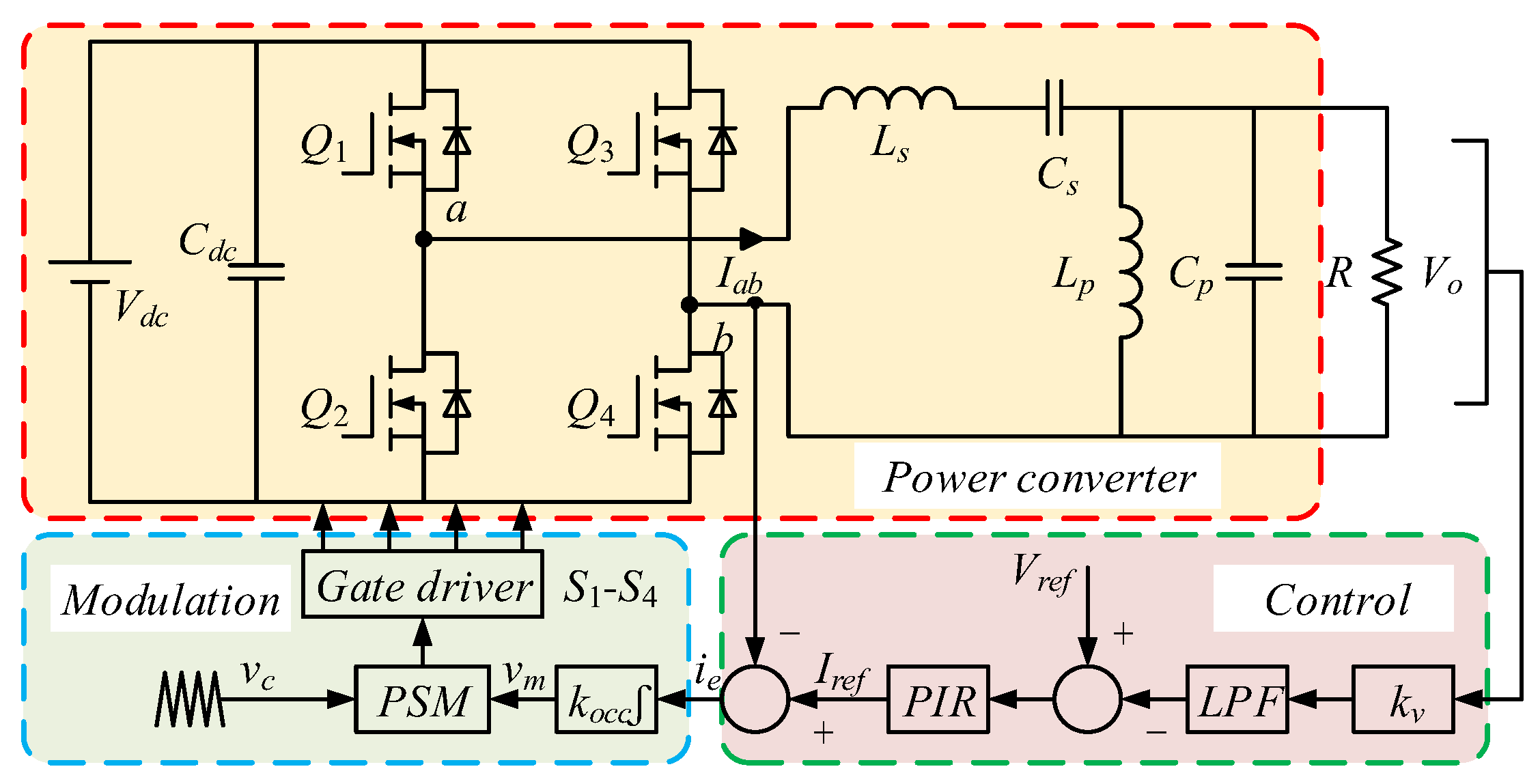





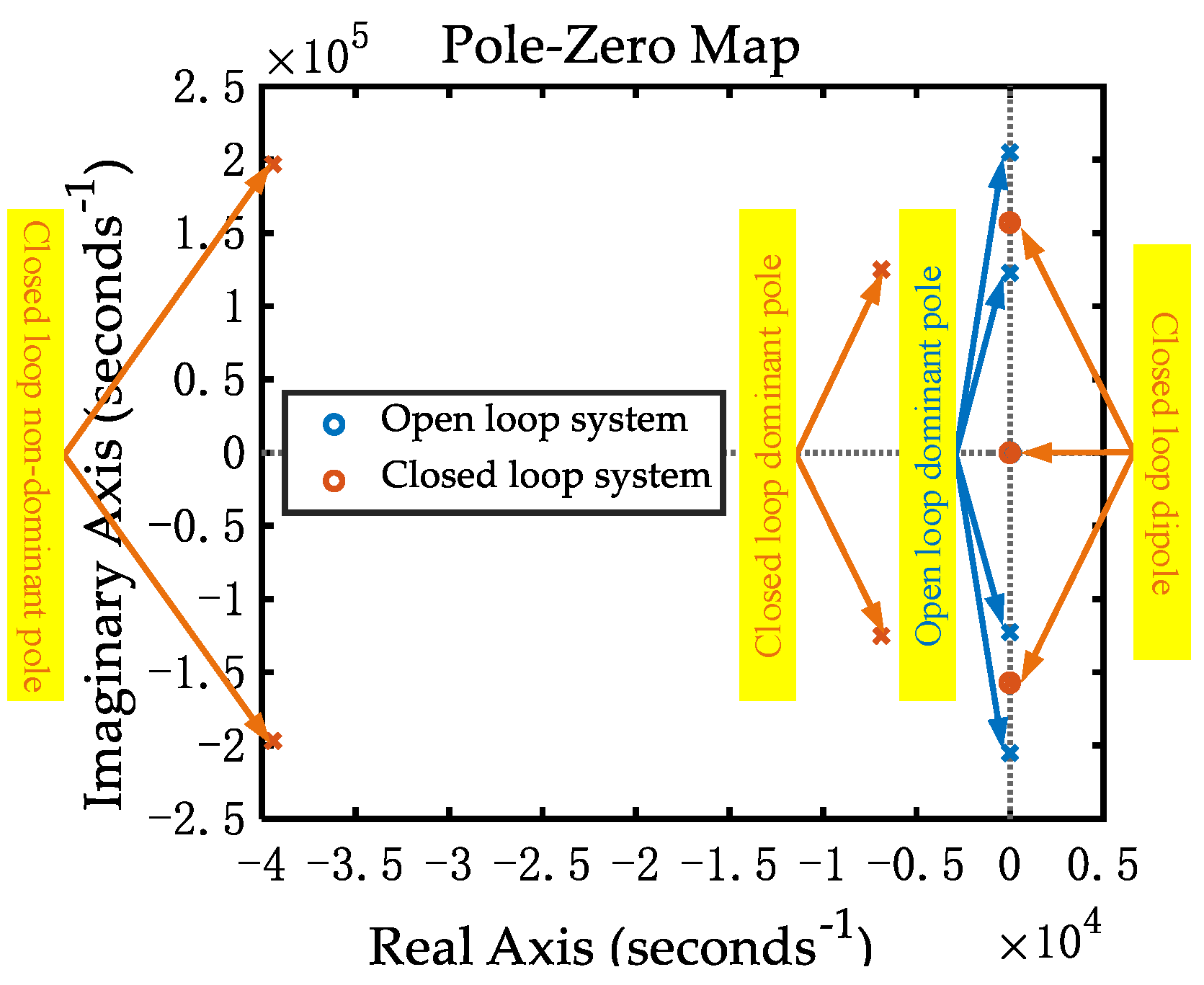
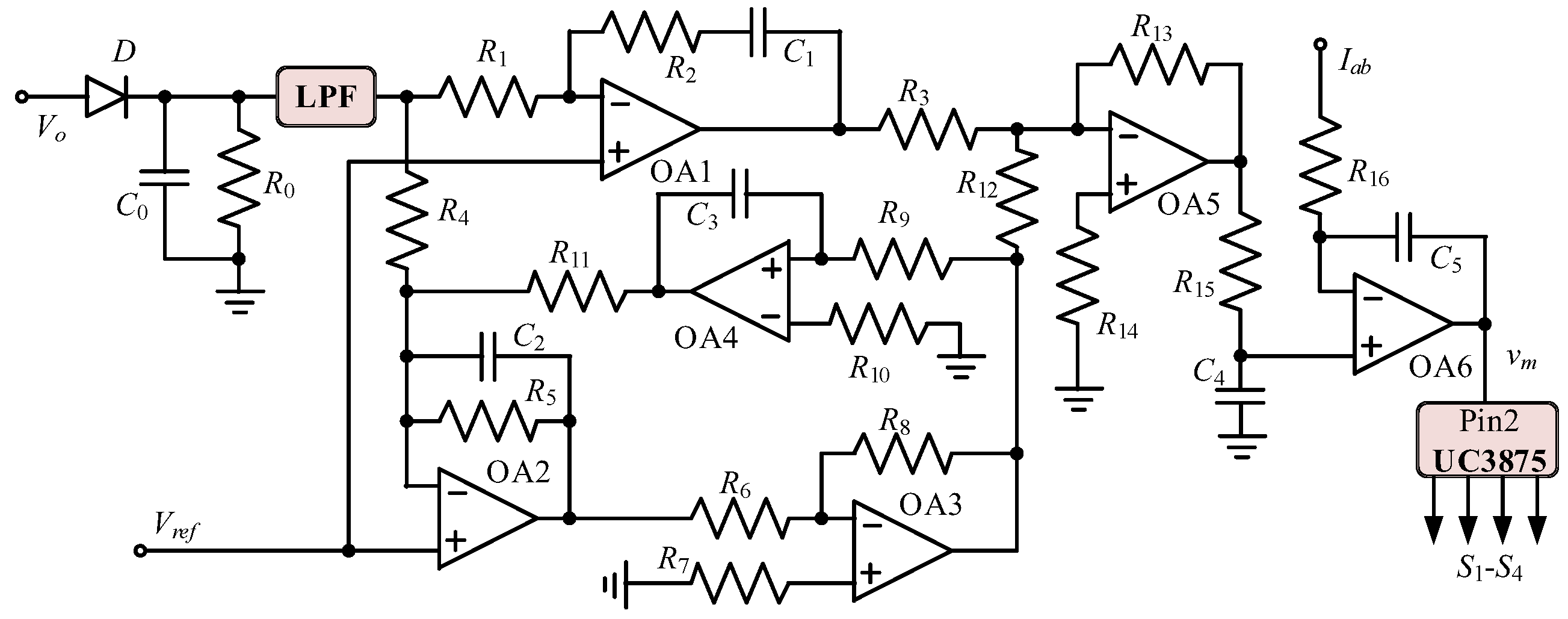

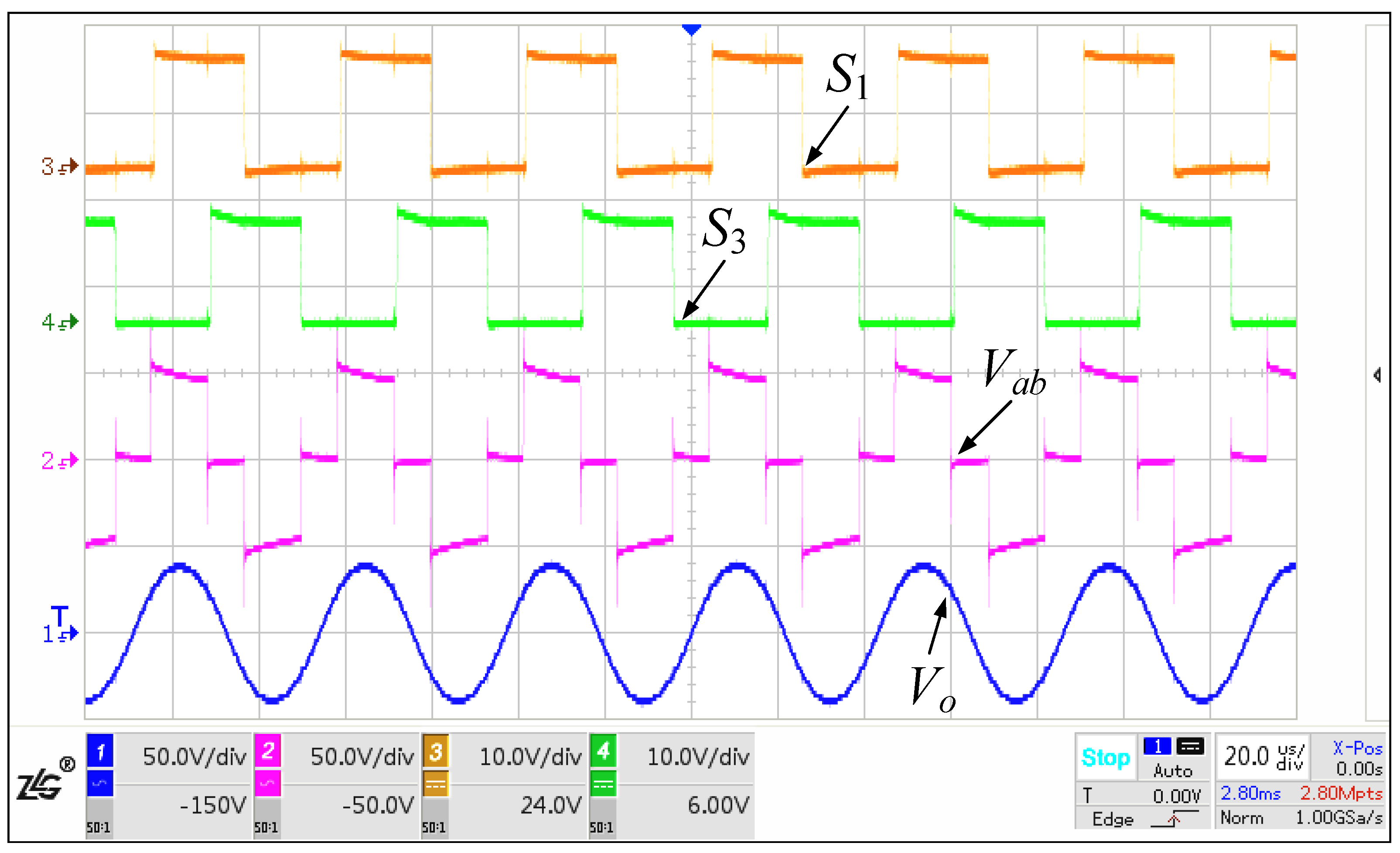
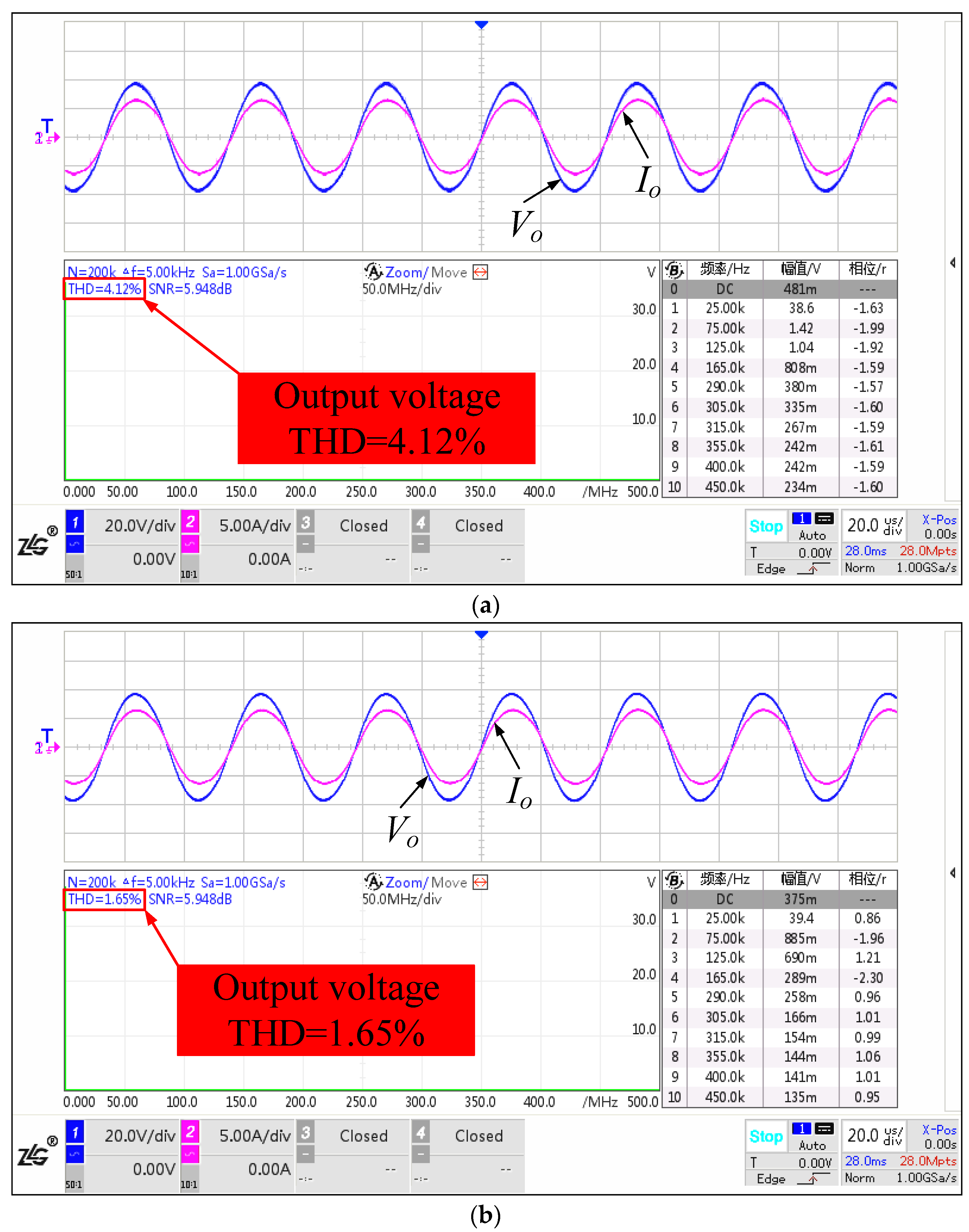
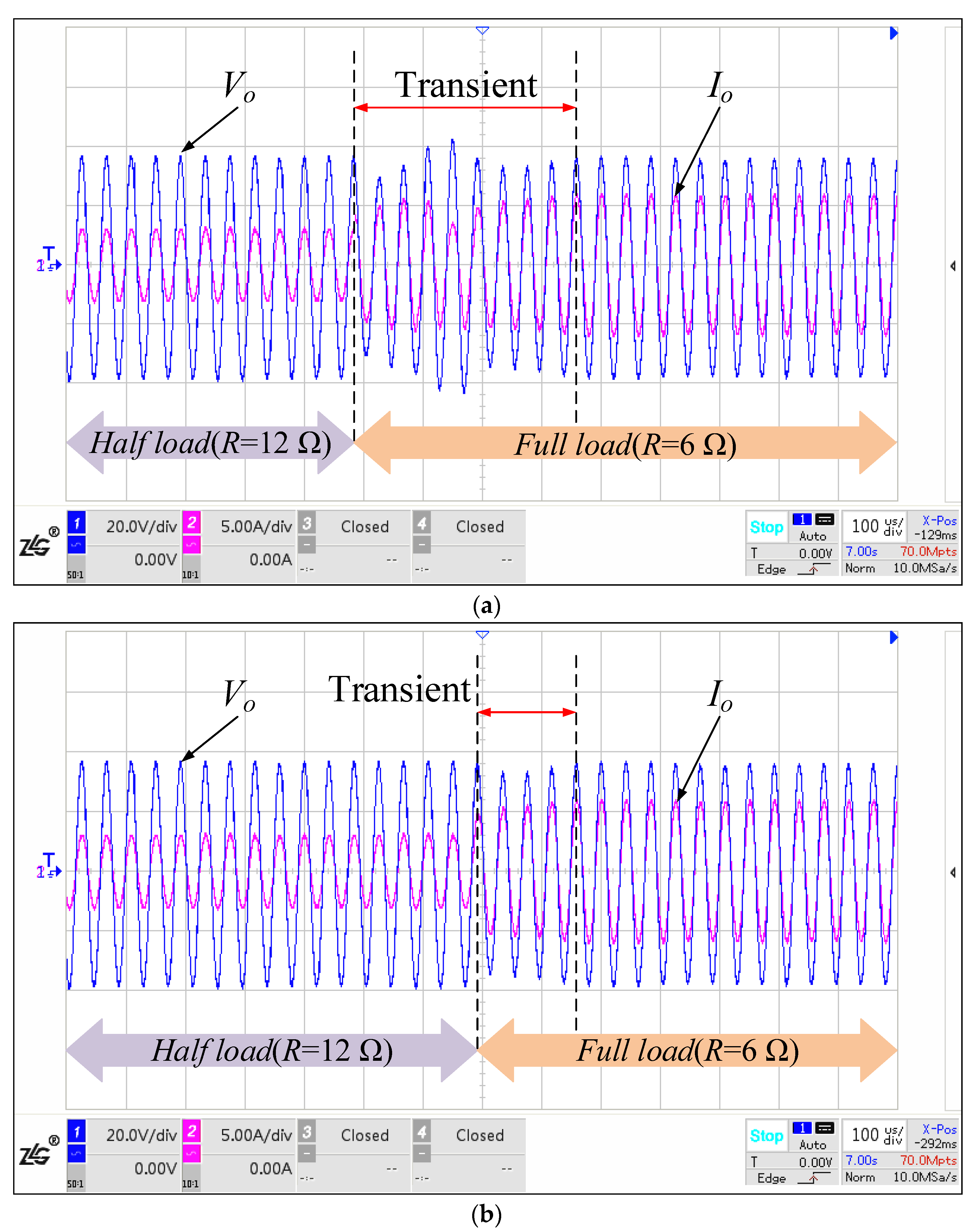
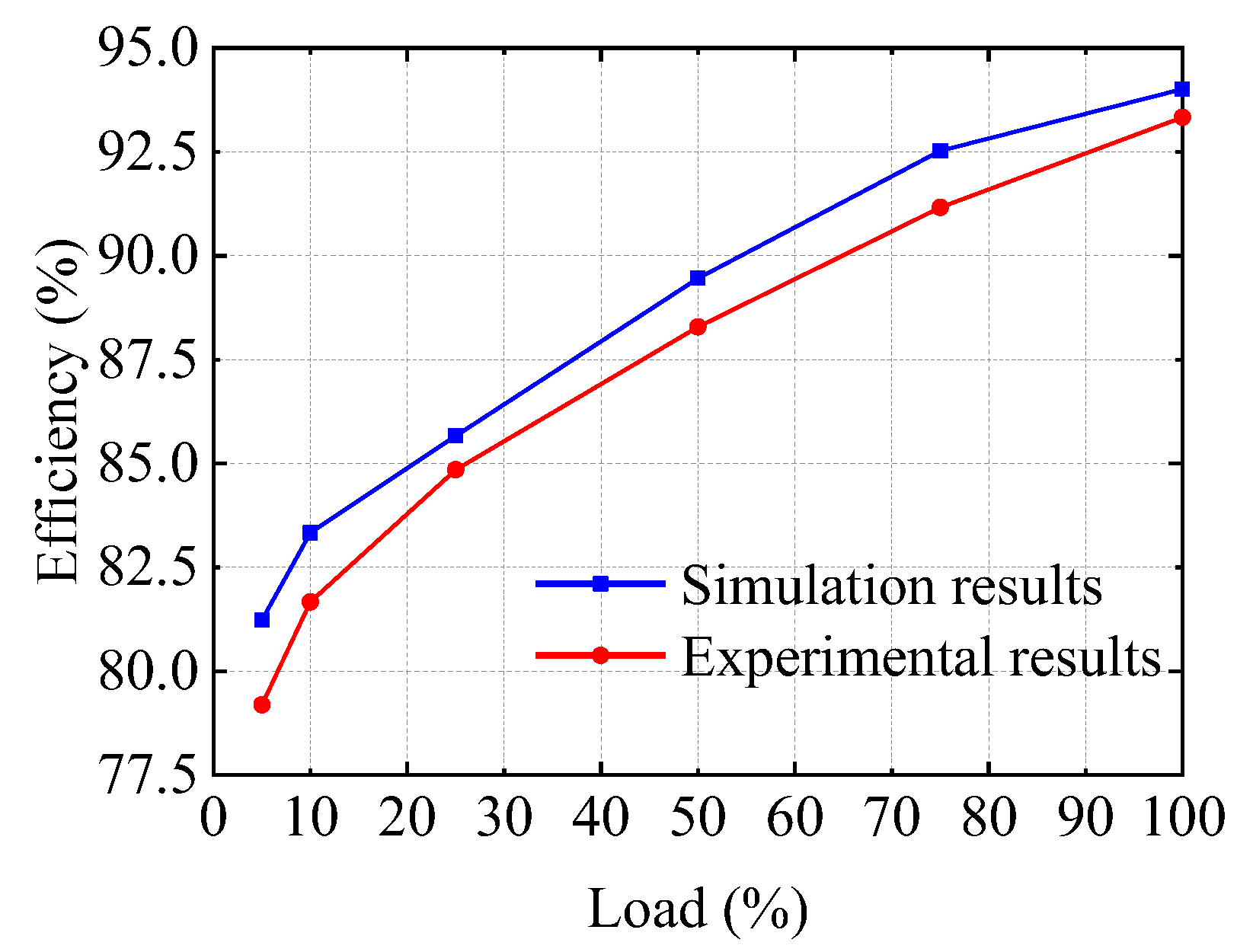
| Specifications | Symbol | Values | Specifications | Symbol | Values |
|---|---|---|---|---|---|
| Rated output power | P | 130 W | Series resonant inductor | Ls | 110 µH |
| Full load | R | 6 Ω | Series resonant capacitor | Cs | 0.47 µF |
| Input DC power supply | Vdc | 50 V | Parallel resonant inductor | Lp | 17 µH |
| Input filter capacitor | Cdc | 220 µF | Parallel resonant capacitor | Cp | 1.8 µF |
| Power switching device | Q1–Q4 | IRF530N | Switching frequency | fs | 25 kHz |
| Power switching driving | S1–S4 | TLP250 | Output voltage RMS and frequency | Vo/f | 28 V/25 kHz |
Publisher’s Note: MDPI stays neutral with regard to jurisdictional claims in published maps and institutional affiliations. |
© 2022 by the authors. Licensee MDPI, Basel, Switzerland. This article is an open access article distributed under the terms and conditions of the Creative Commons Attribution (CC BY) license (https://creativecommons.org/licenses/by/4.0/).
Share and Cite
Zhou, H.; Liu, J.; Fang, Z.; Zhang, P.; Zhang, B.; Ma, M.; Zeng, J. Control Strategy for Resonant Inverter in High Frequency AC Power Distribution System with Harmonic Suppression and Transient Performance Improvement. Energies 2022, 15, 8992. https://doi.org/10.3390/en15238992
Zhou H, Liu J, Fang Z, Zhang P, Zhang B, Ma M, Zeng J. Control Strategy for Resonant Inverter in High Frequency AC Power Distribution System with Harmonic Suppression and Transient Performance Improvement. Energies. 2022; 15(23):8992. https://doi.org/10.3390/en15238992
Chicago/Turabian StyleZhou, Hao, Junfeng Liu, Zijie Fang, Pengyu Zhang, Bolun Zhang, Mingze Ma, and Jun Zeng. 2022. "Control Strategy for Resonant Inverter in High Frequency AC Power Distribution System with Harmonic Suppression and Transient Performance Improvement" Energies 15, no. 23: 8992. https://doi.org/10.3390/en15238992
APA StyleZhou, H., Liu, J., Fang, Z., Zhang, P., Zhang, B., Ma, M., & Zeng, J. (2022). Control Strategy for Resonant Inverter in High Frequency AC Power Distribution System with Harmonic Suppression and Transient Performance Improvement. Energies, 15(23), 8992. https://doi.org/10.3390/en15238992








